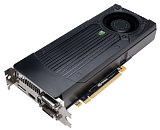Friday, January 17th 2014

NVIDIA Readies GeForce GTX 750 Ti Based on "Maxwell"
NVIDIA's next-generation GPU architecture, codenamed "Maxwell," will debut this February, with the unexpectedly positioned GeForce GTX 750. The card will launch on February 18, to be specific. Maxwell will introduce a host of new features for NVIDIA, beginning with Unified Virtual Memory. The feature lets the GPU and CPU share the same memory. Such a feature is already implemented on the current CUDA, but Maxwell could be designed to reduce overhead involved in getting the thing to work. The next big feature is that Maxwell GPUs will embed a 64-bit ARM CPU core based on NVIDIA's "Project Denver." This CPU core will allow the GPU to reduce dependency on the system's main processor in certain GPGPU scenarios. Pole-vaulting the CPU's authority in certain scenarios could work to improve performance
Getting back to the GeForce GTX 750 Ti, NVIDIA's aim is simple, to see how "Maxwell" performs on the existing, proven 28 nanometer silicon fab process, before scaling it up on the future 20 nm nodes, with bigger chips. Given its name, we expect it to be positioned in between the GTX 760 and the GTX 660 in terms of gaming performance, but we won't be surprised if it falls into an entirely different league with GPGPU. There are no specifications at hand.
Source:
SweClockers
Getting back to the GeForce GTX 750 Ti, NVIDIA's aim is simple, to see how "Maxwell" performs on the existing, proven 28 nanometer silicon fab process, before scaling it up on the future 20 nm nodes, with bigger chips. Given its name, we expect it to be positioned in between the GTX 760 and the GTX 660 in terms of gaming performance, but we won't be surprised if it falls into an entirely different league with GPGPU. There are no specifications at hand.

44 Comments on NVIDIA Readies GeForce GTX 750 Ti Based on "Maxwell"
About a month ago I restructured my finite-difference time-domain code by moving as many decision-making tasks (mostly if-statements) CPU-side as possible. In doing so I removed about 15 if-statements, but added 10-50 extra arithmetic operations per if-statement that I removed. The end result was a 4% performance increase, which given the simplicity of the kernels to begin with is pretty damn good. It will be interesting to see how the addition of the ARM on-board affects all of this.
Man invents GPUs
CPUs become GPUs
GPUs become CPUs
Computers become self aware!!
Man invents Chobits
It should however play games really well and with nvidias recent cross licence with intel they might have something brewing but then again intel did keep x86 off the licence so it may yet be tricky especially since intel seam to have access to nvidias patents and much more leverage in foundry tech then nvidia.
This is panic status releasing by nvidia , , like I said ages ago maxwell (big proper one with 1tb bandwidth nested memory) is 2014 q4 earliest likely 1h 2015 on 20nm unless they have fully ditched tsv attached memory plans which would make for a lot of Bs in nvidias earlier pr slides
It will be interesting to see how much it actually helps with more complicated GPGPU kernels, but yeah I doubt it will approach anything like a 7870 or 280x in the vast majority of circumstances. Seems like more of a niche card.
Mining Kit UKO-K140K: AMD Sempron 2.8GHz Single Core, 6 X Radeon R9 290X 4GB, 4GB RAM, 2 X 1500W 80 PLUS Gold Power Supply
All this can be yours for only: $4,119.99!!
It's only a matter of time before Nvidia steps into the ring, and then it's off to the races so to speak, dunno yet what part Maxwell will play in this game... :(
I'm all for gaming and computing inspired innovation, and I really hope Nvidia is focusing on that with Maxwell, but the Pandora box has been opened, and fact is there's a big market in the mining business right now, and sooner than later we'll have two contenders in this arena.
I'm looking forward particularly to what Maxwell will bring in terms of power efficiency, not very exited about the desktop parts, but mostly about the mobile parts!
At least they could throw in 6 PCIE risers and a piece of a PC gamer's soul :cry:
Like poor core bin but max gpu array bin